
|   |

|   |
Virangana, Storytellers, and Aanurakti - Tapati Chowdhurie e-mail: tapatichow@yahoo.co.in May 15, 2024 VIRANGANA There seems to be no dearth of creativity in the dancers of Kolkata as seen in a few of the productions of the recent past. Bharatanatyam dancer Sutapa Awon Pradhan's 'Virangana' performed at Gyan Manch is a prime example. 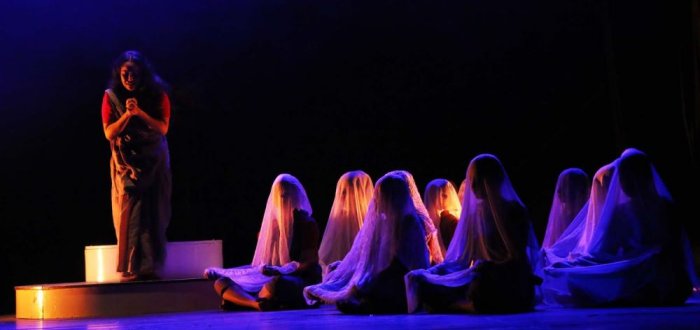 Virangana nayikas 'Virangana Kavya' - poems by Michael Madhusudan Dutt written in the form of a series of letters compiled from our ancient literature and the epics - is about the adventures of eleven strong revolutionary and courageous women, who have displayed heroism in multifarious ways. 'Virangana Kavya' was published in1862. It was dedicated to the social reformer Vidyasagar. During the 19th century, India was going through the 'Renaissance Movement', which was inspired by post-modern education. During Renaissance, the abolition of superstition, women's education and their emancipation were the main tools of the educated people. Raja Rammohan Roy's efforts to eradicate the prevalent evils of our society, Devendranath Tagore's efforts to promote the education of the girl child and Vidyasagar's efforts to prevent child marriage and the remarriage of widows were articulated beautifully by the revolutionary poet Michael Madhusudan Dutt. Sutapa Awon Pradhan chose to depict a few of the revolutionary characters from 'Virangana Kavya', whose courage, determination and dignity are worthy of emulation. Rather than adhering to present what she has learnt from her gurus, Sutapa Awon has delved deep into the rich literature of the country to put it in the language of dance. Srabasti Ghose as Shakuntala, Asmita Dey as Brihaspati's wife Tara, Auishani Roy as Urvasi, Megha Sasmal as Surpanaka, Shreya Roy as Niladhawja's wife Jana and Bhanumati by Paramita Dutta transported the audience to a world of aesthetic beauty, with their art of story-telling through folk and classical dance. 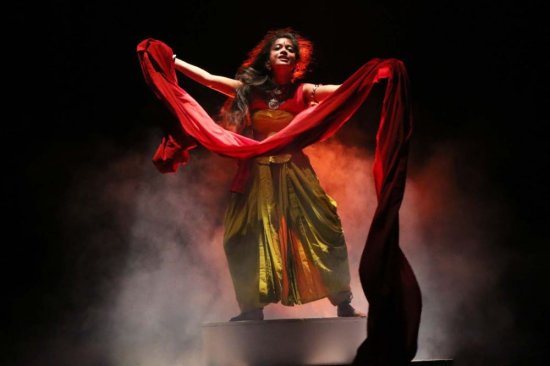 Virangana Sutapa Awon has used Chhau dance of both Seraikella and Mayurbhanj, war dance of the Paikas and certain elements of Jhumur besides Bharatanatyam in her seamless production. Music composition of Nilangshuk Dutta and the conceptualization of the stage design by Tarun Pradhan added to telling of the story of the powerful women as did the light designs of Dhanapati Mondal. In the choreographer's note Sutapa has said that the dancers who depicted the characters were viranganas of modern times who meet the challenges of the times every day, to pursue their passion. She therefore felt the need to see these viranganas depict the life of yester-year viranganas. STORYTELLERS Photos courtesy: Suman Sarawgi 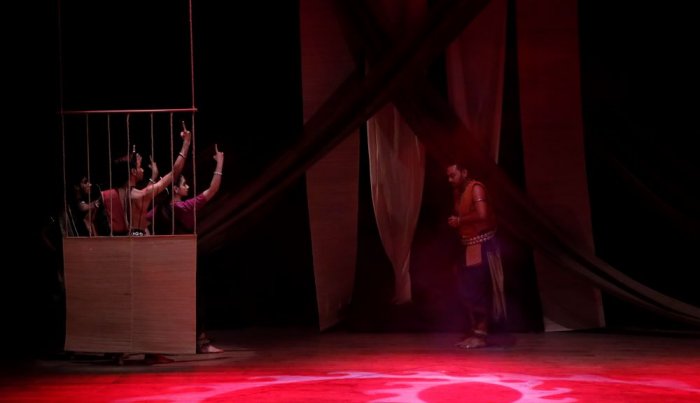 Storytellers 'Storytellers' by Sharmila Biswas - a three-day long festival - was once again a proof of her creative and thinking mind, that constantly extends the boundaries of her learnt genre, which has taken long steps in enriching the Odissi dance form. Presented by Sparsh Studio of Suman Sarawgi with Gouri Basu as the Master of Ceremony, the festival was one of continuous story-telling at Gyan Manch in Kolkata. Pagdandi -Winding Path - performed on day one, consisting of a traditional repertoire and Manodarpan, a dance-theatre production presented on day two, was watched attentively by an appreciative audience. Sharmila Biswas has compared the journey of her life to pagdandi, which is basically a footway starting from the base of a hill meandering its way in spirals to reach the top, where with each step taken upward the vision changes to something new. It's only on reaching the top, can one see the design in its entirety. She recounted how in the course of the past three years with much struggle, she has more clarity of thought in understanding the Odissi Marga. Pagdandi was uniquely conceived. Patachitra paintings inspired her to include Padmapuran Mahalakshmi as an invocatory piece in her repertoire, which she presented with music direction and rendition of the very talented Srijan Chatterjee, put into rhythm under Bijaya Kumar Barik's direction. The piece danced as Mangalacharan served as the gateway to the main performance and it had a calming and joyful effect on the minds of the audience. The dance, the choreography and the music was simple yet strong with an element of surprise. Padmapuran Mahalakshmi more than fulfilled the aims of the Mangalacharan as conceived by the versatility of the choreographer. Kundalika Pallavi followed closely on the footsteps of the invocatory piece, which revealed the beauty of Odissi dance technique and elaborated the intricacies of its stances, and body movements, through elaboration of raga and tala. A piece of shuddha nritya - pure dance - has no story to tell, but the choreographer's question is, "Although there is no story to be told, can any dance be devoid of meaning, attitude and spirit?" The emotion of joy and contentment prevailed. Each movement led to the next meaningfully. There was a progression and so as a whole it did tell a story, however abstract. Kundalika was inspired by the spiral movements which is humanity's most ancient and mysterious symbols. Spiral movements or Bhramaris, exists in all dances in the world. They add beauty and excitement to dance, creates a feeling of unending movements and displays body lines from all angles, showing changes. Subramani Ramesh Chandra was the music composer of 'Kundalika', rhythm composition and execution was by Budhhanath Swain, and voice rendition by Srijan Chatterjee. The choreography incorporated all the 22 circular movements of Odissi dance. Pallavi was followed by abhinaya on Kavi Jayadeva's Dasavatar or the 10 incarnations of Vishnu. In Dasavatar or Shrishtitatva the visualization, the vocalization and chanting of the lyric had an angle that was Sharmila's very own. The audience watched it wide eyed. Srishtitatwa or the knowledge of creation, which has been there in the Puranas were interpreted by the medieval Vaishnav poet and saint Jayadeva in Dasavatar. Music composition and the voice by Srijan Chatterjee with the rhythm composition of Sharmila Biswas and its execution by Bijaya Kumar Barik gave the piece a new dimension. Divine Puppeteer, the abhinaya piece where the dancer narrated her thoughts to the words of the lyric, was the centre piece of the presentation. Sharmila has chosen this famous Sankeertana written in Telugu by Annamacharya, because she feels that in every region of India, there are some classics, which transcend all boundaries. They need to be shared by all artistes, keeping all the nuances of the region intact. The first line of the lyric set the mood. The devotee is sure that the Almighty has joined a group of puppeteers and all human beings are his puppets. Music of the piece was by Sathiraju Venumadhav sung in raag Kedargowla and taal khanda chapu. Sharmila Biswas is a performer par-excellence. Her emotive power was at its best. A saree worn by her in the fashion of a stitched costume fitted the bill. Vocalist DSV Shastri was also the nattuvanar. Monami Nandy, Krishnendu Saha, Ankita Kulabhi, Raaginni Hindocha, Kaushik Das, Dipjoy Sarkar, Yotishree Bose and Sharmila Biswas danced their way into the hearts of the audience. 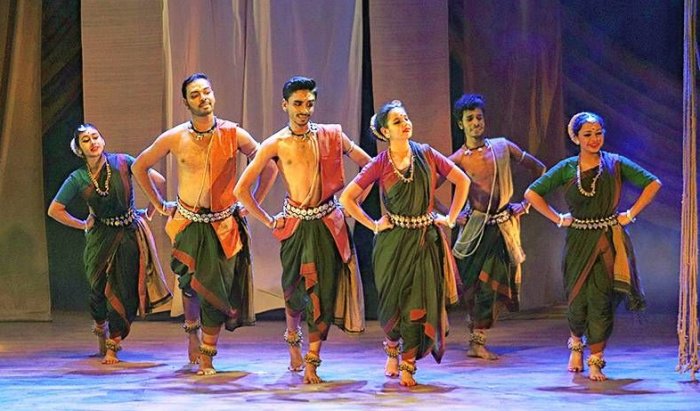 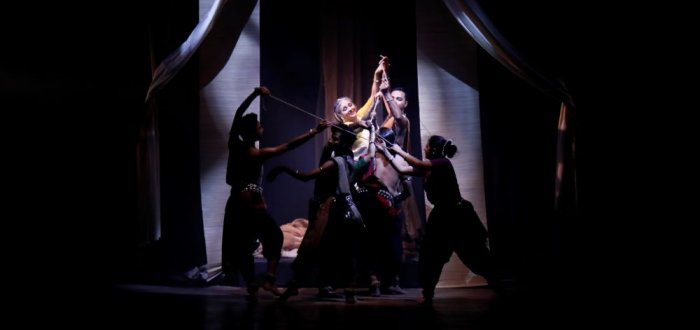 Manodarpan Manodarpan - Reflections of Life was expressed through bhava and rasa. Each of the nine rasas of Natya Shastra tells a story - stories of human feelings which are real, were told through powerful, energetic and vibrant Odissi dance, with Sharmila's aesthetic skill extending its boundaries - stark and intense and deep rooted while at the same time contemporary - for rasas are eternal. The three abhinayas depended heavily upon were Angika, Vachika and Aharya. Manodarpan was the result of the workings of an extremely liberal mind that has knowledge of not only dance but also theatre. The third day was devoted to a workshop by Sharmila Biswas at Odissi Vision Movement Studio as well as online, where she worked on the topic "The intimate act of Choreography". AANURAKTI Photos courtesy: Shrobana Mitra Das Manipuri practitioner Shrobona Mitra Das, Artistic Director of Salt Lake Riyom Society for Manipuri Dance and Movement Therapy presented 'Aanurakti ..the Passion' at Rabindra Sadan, Kolkata, in celebration of the completing of her 25 years of artistic journey. She inaugurated the evening with a dance by the special children of South Kolkata Parashmoni. Guru Vandana and Dasavatar of Jayadeva's Geeta Govinda set the tone of the evening. 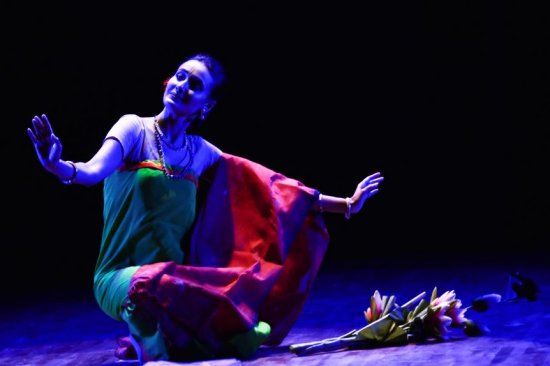 Shrobona Mitra Das 'Kumhei.... the celebration of Life!' was Shrobana Mitra Das' unique presentation. Kumhei was the celebration of life and most importantly it was the celebration of womanhood. Manipuri women - known for their valour, skill and active involvement in social, economic, political and cultural activities - were the highlight of the piece. Glimpses of Lai haraoba performed in praise of Umang-Lai by Maibis enacted by Shrobana was spectacular. The contribution of women in the economy of Manipur was shown in detail in the piece. The intricately woven handicrafts and handloom goods popular in states outside Manipur; weaving, silk rearing, yarn making, embroidery, pottery, fishing, and in the agricultural sector women's contribution out-does the contribution of their male counterparts. Women's participation in agricultural activities, right from sowing the paddy, weeding, husking and winnowing as well as taking part in the administration of the kingdoms in ancient times were aesthetically shown through dance movements by Shrobana. The incident in 1980, that triggered the sudden collective movement known as Meira Paibis to safeguard the youth by keeping a strict night vigil with lit torches in their own locality was included in the choreography. Shrobana's presentation of Kumhei with Ina Chaklanobish Bagchi's voiceover paid a rich tribute to the women of Manipur. The second half of the evening was devoted to seeing talented artistes of other genres perform. 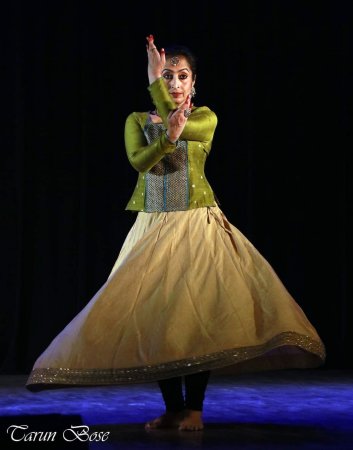 Debashree Bhattacharya Kathaka Debashree Bhattacharya - disciple of Rani Karna - and Brindar group delved into the mysteries of the working of the universe; what is nature, who are we and what is our relationship with nature and such other thought provoking elements in her choreographic work in 'Bhumistha - life on earth', an excerpt from her production Panchbhootani. The impeccable style of Kathak that Debashree has learnt from her Guru Rani Kaarna was marvellous. The spins, the tatkars, and the technical aspects of Kathak were impressive. Mohiniattam exponent Pallavi Krishnan, Artistic Director of Lasya Dance Academy, presented her students Anusree Kundu and Antara in Ashtalakshmi on carefully chosen verses from Mahalakshmi Ashtakam Stothram from Padmapurana, which is about the divine energy of goddess Mahalakshmi. Parashakti is an all-pervasive pure consciousness and primal substance of all that exists in the form of Mahamaya or Devi, worshipped as Parvati, who is the store house of power; Mahalakshmi, who is the Goddess of wealth and Saraswati the power house of wisdom. Mahalakshmi who represents all the three energies of power, wealth and wisdom was danced in the graceful style of Mohiniattam. The piece was in Ragamalika and Talamalika composed and choreographed by Pallavi Krishnan. The art of the Mohini permeated in the audience as the duo extolled the qualities of Devi. The perfectly rendered style noted for its circular movements like the coconut palms swaying in the breeze and the waves created by the seas and oceans touching the shores of Kerala endeared aficionados into the art form as taught to them by Bengal's own daughter Pallavi. Kathakali aspirant Ramyani Roy's Puthana Moksham, the popular legend of the redemption of Puthana in the hands of Krishna, was engrossing. The transformation of the beautiful damsel in the immaculate stree vesham costume of Kathakali later into her demonic self was blood chilling. 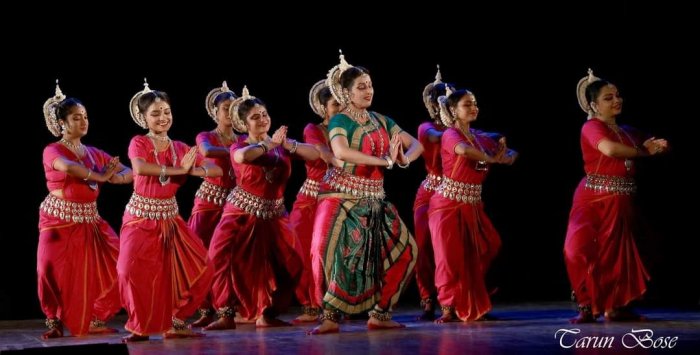 Arpita Venkatesh and group Odissi dancer Arpita Venkatesh performed Jayadeva's ashtapadi "Srita Kamala Kuchamandala" - a composition of Guru Kelucharan Mohapatra in Misra Chhayanot raag and taal Joti, with her group. The rendition left a mark on the audience. Bharatanatyam performer Milan Adhikary's Tillana was impressive. Shrobana Mitra Das concluded the festival beautifully with Krishna Rativilas and Vasant in Manipuri with her disciples Chandrabali Dasgupta, Sonami Roy Chowdhury, Shreshtha Adak, Aparajita Chakraborty, Soma Mukherjee, Asmita Chowdhury, Sumit Mukherjee, Arunima Bose and Malabi Chowdhury.  Tapati Chowdhurie trained under Guru Gopinath in Madras and was briefly with International Centre for Kathakali in New Delhi. Presently, she is a freelance writer on the performing arts. |